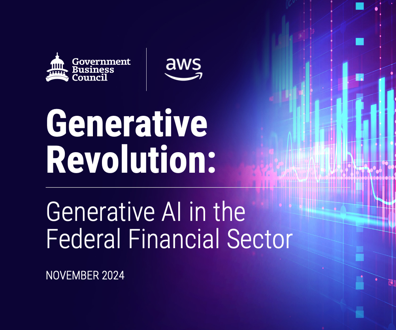sponsor content What's this?

iStock/gorodenkoff
The Magic of Managed Services: Speeding Government Digital Transformation
The COVID-19 pandemic gave digital modernization in government a much-needed boost. But how can agencies keep the momentum up and how can they ensure they’re well-positioned to deal with the next crisis? At the Emerge 2021 event, government leaders touted the ways they are tapping managed services to do just that.
Presented by
GDIT 2021

What will the government look like in 10 years? That was the question on everyone’s lips at this year’s Emerge 2021 summit, a virtual event series from GDIT built to bring together government and industry leaders to discuss how technology is making a difference when it comes to meeting the mission both today and tomorrow.
As leaders and innovators met to discuss that question across a series of panels, it became clear that the answer to the question was unanimous.
“Across the board I’m hearing people say: ‘It is enabled by technology,’” explained Krista Kinnard, chief of emerging technologies at the Department of Labor during the “Technology Vision Panel 20/21” session. What that means, explains Kinnard, is that government organizations across the board are looking at ways to minimize menial and manual tasks in order to free up staff to turn their cognitive attention to places where it would make the most impact.
It also means creating a landscape where technology can help government operate more quickly, effectively and with greater agility.
“We are under increasing pressure to reduce backlogs, promote transparency and increase efficiency,” noted Maria Roat, deputy federal chief information officer for the Office of Management and Budget during her keynote address. To combat that, government agencies are beginning to look at tools like artificial intelligence, machine learning, Robotic Process Automation (RPA) or natural language processing, among others, that promise to help agencies both solve the problems of today and boost operations tomorrow.
To take advantage of these technologies, however, requires that agencies across the board embrace digital modernization, transforming their technologies and processes into ones that can deliver on the promise of tomorrow.
But with budget constraints, hiring and procurement challenges and other hurdles that government organizations are privy to, how can agencies modernize quickly enough to ensure they are offering modern, digital customer experiences and meeting the mission effectively? Not to mention ensuring they’re keeping pace with emerging tech and cyber threats? Managed services offer agencies a fast, cost-effective path to modernization. Here’s three ways experts and speakers at the conference noted that managed services can — and already has — help agencies move the needle on digital transformation.
1. Adapting at Light Speed
The COVID-19 pandemic came with a substantial set of challenges, but chief among them was the need to rapidly adapt to remote and digital operations virtually overnight.
The Department of Veterans Affairs felt the full force of this change as the agency sought to continue providing healthcare services to veterans while keeping both staff and patients safe. The answer came in the form of telehealth services: through virtual visits, providers could safely treat patients from a distance. But rolling telehealth out at scale proved to be a massive change to the typical in-facility operations the VA was used to running.
Luckily, the VA had worked both internally and with vendor partners to begin its digital transformation efforts and adopt cloud about five years ago, leaving them well positioned to pivot quickly to the crises, said Dominic Cussatt, acting assistant secretary for Information and Technology, and CIO for the Department of Veteran Affairs, during a the “Accelerating Modernization with Managed Services” panel.
“Having these vehicles and managed services in the cloud allowed us to act very decisively and very quickly,” said Cussatt. “Because of those cloud platforms that were readily available and ready to scale with built-in security and then also…we had good vendor partnerships and relationships and we had good contract vehicles that allowed us to scale for things like the end user device equipment that we needed to outfit a newly remote workforce. We had the equipment we needed to support telehealth encounters.”
2. Managed Services as a Force Multiplier
Going forward, as the pandemic wanes, the VA can choose to scale down those services as needed. But an added benefit, Cussatt noted, is that the user experience is such that the agency may not need to scale down its telehealth services at all.
“We’re seeing those telehealth numbers stick and that speaks to us as a positive customer experience,” said Cussatt, noting that patients are finding virtual visits more convenient in many ways than in-person visits, particularly when it comes to the time and effort it takes to reach a provider. “Because of this technology, the scalable managed service platforms that we have with high-quality video encounters and audio encounters, that takes the technology right to the veterans’ own devices…the encounter is actually very rich.”
Importantly, by providing a rich digital experience, the VA is able to reach more veterans than before, something it only sees growing as telehealth continues to catch on and technologies and bandwidth constraints continue to improve.
“It’s a force multiplier for us,” said Cussatt.
It’s not just the VA that’s able to reach more constituents by tapping digital managed services. Mia Jordan, chief information officer for the Enterprise Technology Directorate at the Federal Student Aid
Department of Education, notes that managed services allowed the FSA to similarly move the needle on digital and cloud services in ways that enable the agency to meet more people where they are.
“We in the government and like everyone else are required to communicate with our customer base in various ways because we have a very large demographic of customers,” said Jordan. “We have everyone from millennials all the way through your Baby Boomers and they each like to connect with you in different ways, and so these platforms provide us with the tools to be able to reach each and every one of those demographics without a hitch. That’s the real value.”
3. Setting the Stage for the Future of Government
Moving ahead, while the COVID-19 pandemic was a challenge in many ways, it also added a much-needed boost to government digital transformation and, overwhelmingly, agency leaders during the conference expressed the desire not to continue innovating and transforming operations.
“While it was a negative thing that put us in this place…now it’s all about how do we remain on par with the rest of industry, with the rest of the critical infrastructure that’s in place such that if the next issue that comes along this pivot isn’t as challenging?” asked Jordan.
Importantly, constituents and users have come to expect these types of services from government.
“I can’t imagine that it’s going to slow down now,” said GDIT Program Senior Director Shaleen Braley, during the breakout session “Making the Move to Outcome0Based Managed Services. “When we saw that rapid digital transformation across every industry, I can’t imagine it’s going to go backwards. If anything, customers are going to expect the internet of things, they’re going to expect that consumer experience in DOD.”
Specifically, said Braley, constituents and agency staff alike are going to look for the same ease-of-use and self-service that commercial entities deliver. To keep up with that expectation will require that agencies continue to embrace digital transformation.
“The federal government, it must continue to adopt new technologies, new techniques, new approaches to keep up with the pace of change,” said Roat during her keynote speech. “We have to continuously modernize the systems and the ways we work. We have to foster a culture that embraces risk and agile adoption and encourage innovation not just in technology but also in areas like acquisition. That digital delivery is a necessity in our customers, internal employees, the external American public — they expect that delivery to be quick, easy, secure and accessible.”
So, how can agencies ensure they’re making that change and adopting emerging technologies like RPA, machine learning, artificial intelligence and natural language processing, among others, in useful and transformative ways that can continue to push the envelope and deliver secure, cutting-edge services?
The answer lies with the technology itself, according to Braley.
“We need to allow technology to drive. Allow technologies to inform policies and best practices,” she said, noting that this approach is, of course, about balance and there’s no need to rewrite everything, “but we need to understand where technology is headed in terms of allowing organizations to scale and to grow.”
Check out Emerge 2021 to learn more about how GDIT can help your agency embrace digital modernization.
This content is made possible by our sponsor GDIT; it is not written by and does not necessarily reflect the views of GovExec’s editorial staff.
NEXT STORY: Road to Digital Maturity: How Agencies Are Embracing the Modernization Journey






